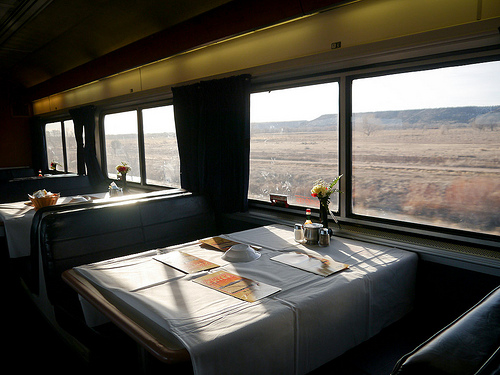Happening Now
John Mica’s Circus Sideshow, Part ∞
November 14, 2013
Written By Malcolm Kenton
Rep. John Mica (R-FL) held yet another hearing this morning focusing on the financials of Amtrak’s food and beverage (F&B) service. NARP has never been shy to point out places where Amtrak could improve. But it’s time to restore a modicum of perspective to this whole process; Mica’s intense focus on this one aspect of Amtrak’s business is completely misdirected.

Asking Amtrak to treat its F&B—a mere 1.8% of all the costs Amtrak incurs, after factoring in a 65% cost-recovery rate—is like trying to balance the $1 trillion budget by focusing on Amtrak’s $1.4 billion annual grant—something Representative Mica is earnestly attempting to do, if you look at how much time he’s devoted to the subject.
But even looking just at the balance sheet, Amtrak reduced its F&B loss by over 30% from 2006 to 2012.
Here’s a fact: Amtrak would lose $93 million in ticket revenue if F&B were eliminated. Amtrak’s Chief of Customer Services Tom Hall testified that when the company switched from hot meals to a sandwich basket in Acela Express First Class, so many passengers switched to Business Class that the cost in reduced ticket revenues outweighed the food and beverage savings.
It’s not as if Amtrak’s F&B cost structure is out of line with the rest of the travel industry. Airlines spent an average of $5.45 to $6.46 per passenger on F&B since 2008, during which time Amtrak spent an average of $6.95 per passenger, while providing a generally much higher-quality product. And the airlines’ figures don’t even include labor costs, which Amtrak’s figure does include.
Mica suggests that Amtrak follow the example of the Alaska Railroad and Rocky Mountaineer, both tourist-oriented trains whose trips last 10 hours or fewer and don’t run overnight. Amtrak F&B employee Dwayne Bateman, who testified at today’s hearing on behalf of his union, said this makes no sense—F&B is a much more vital, yet more costly, part of overnight trips that can take as much as three days. Long-distance trains’ F&B employees work 16-hour days at minimum, or up to 46 hours in a 68-hour window. Even on the Northeast Corridor, a single café car employee’s shift lasts between 12 and 18 hours (two round-trips from Washington to Boston). Maine’s Downeaster, one of only two routes not to use Amtrak employees in the café car (the other, North Carolina’s Piedmonts, use vending machines) operates the café cars at a loss, and employees of F&B vendor Epicurean Feast make less and have poorer benefits than Amtrak employees in the same positions.
Congressman Mica has belabored the point about Amtrak’s F&B service enough. He’s already won: the railroad has introduced a plan to eliminate food & beverage losses in the next five years. It’s time to stop trying to slice off pieces of America’s rail network, and start working to grow the network to meet surging passenger demand. After all, even Amtrak Inspector General Ted Alves, who’s report initially helped spark this tempest in a tea pot, was quick to point out that much of this positive trend arose from increased volume.
Now that’s food for thought.
Dining car on Amtrak's Southwest Chief
Photo by Flickr.com user Night Owl City.
"Thank you to Jim Mathews and the Rail Passengers Association for presenting me with this prestigious award. I am always looking at ways to work with the railroads and rail advocates to improve the passenger experience."
Congressman Dan Lipinski (IL-3)
February 14, 2020, on receiving the Association's Golden Spike Award
Comments